Hi House Nerd,
I live in an old home in Fremantle that I am renovating and would love some tips on how to reduce road noise in my house. Being close to the street and constructed of weatherboard I hear every car that passes and it is getting quite frustrating especially when trying to sleep. Have you written any blogs on this problem and methods to solve it?
Many thanks,
Alexia
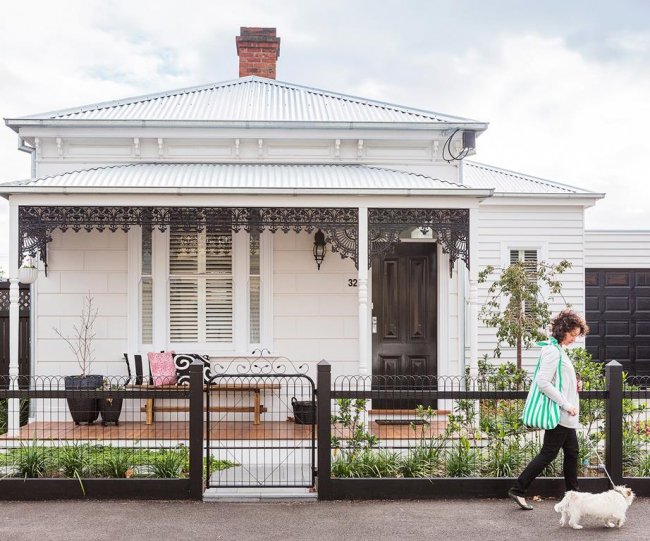
I adore this beautiful inner-city home from Homes to Love. Photo by Maree Homer.
Maybe there is something in our drinking water but this past month I’ve received not just one but three emails from different readers asking if I can do a story on how to minimise external noise in a suburban home and make their home quieter, because living in a noisy locale is slowly driving them nuts.
Well, when I get three separate requests about writing about one topic, I try to do it. Guys, I aim to please. Your wish is my command; email and I shall blog (usually. Don't get too kinky on me).

So back to reducing noise in a home. Firstly, I know some of you guys are probably quite surprised that I feel so enthused about writing on this topic, because, as many of my close friends will attest, I am as deaf as our doorstopper (an antique clothes iron, wooden handle, a Melville Markets find by my in-laws, very cool doorstopper). But I digress.
Yes, I am severely deaf. I rely very heavily on hearing aids all the time except when I am showering, swimming or asleep; have been wearing them since I was four years old and if you want to communicate with me when I’m not wearing them I hope you are very good at expressing yourself through interpretative dance. My patented ‘pleasantly blank I have no freaking idea what you are saying’ face is often a source of exasperation or mirth for others (and yes, I may not hear you but I can tell you are giggling to yourself, thank yaw).
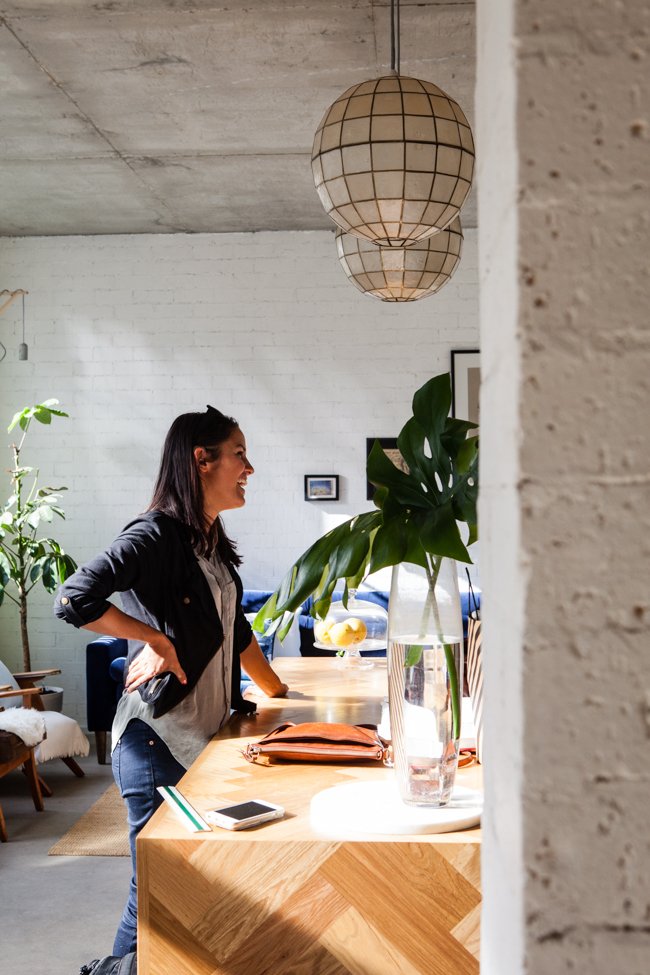
Admittedly, while being deaf has been the cause of a lot of difficulties in my life, there are actually many situations where I actually LOVE my quiet bubble (for example, it’s very useful on flights when there is a baby). And so for this reason, when three House Nerds with able hearing tell me they can’t stand the noisiness of their home, I totally feel for them.
A few years ago, I was fitted with new digital hearing aids that suddenly amplified ALL these noises that I never really noticed in my life before. All of a sudden I could hear the fridge buzzing, the air con, the hum of the computer, cicadas and cheerful frogs apparently having raging parties in our garden all night long. Traffic was louder. Going from relative silence to noise drove me nuts.
Even years on now, I’m not quite used to all these new sounds, and I turn my hearing aids off to write, because the hum of the computer, that I never picked up before, makes me feel edgy. A lot of people like to work with music on but I like to write in absolute silence. (There are still a lot of things I don’t hear, but I don’t mind. I can’t hear people breathing, and I’ve never heard the buzz of a mozzie in my life - in fact I didn’t even know they made a noise until a few years ago, although I have been assured I am not missing out on much!) So I very, very much feel for house nerds who live in a noisy location that is grating on your nerves, whether it's noise from traffic, aircraft or loud neighbours. In my own hearing impaired way, I understand.

If you are building a new home on a busy street or otherwise noisy area, a good architect or designer will be able to come up with ways you can minimise the amount of external noise inside your home. They might situate your garage in a position where it will help block noise from a busy street corner or suggest an atrium-style courtyard garden with water feature to help cut back on traffic noise in your rear bedroom wing.
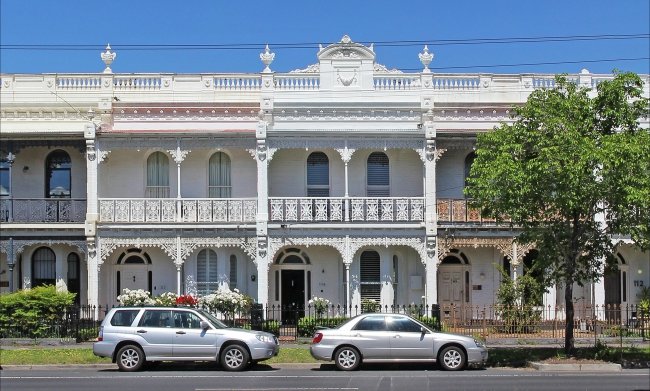
Fret not, though, if you are renovating a home or decorating your existing home as it is – the good news is that there are still lots of sound-reduction strategies you can utilise to minimise noise pollution in your home, bit by bit! This article is for you.
WHEN YOU LIVE NEXT TO NOISE: MAKING YOUR HOME A QUIET HAVEN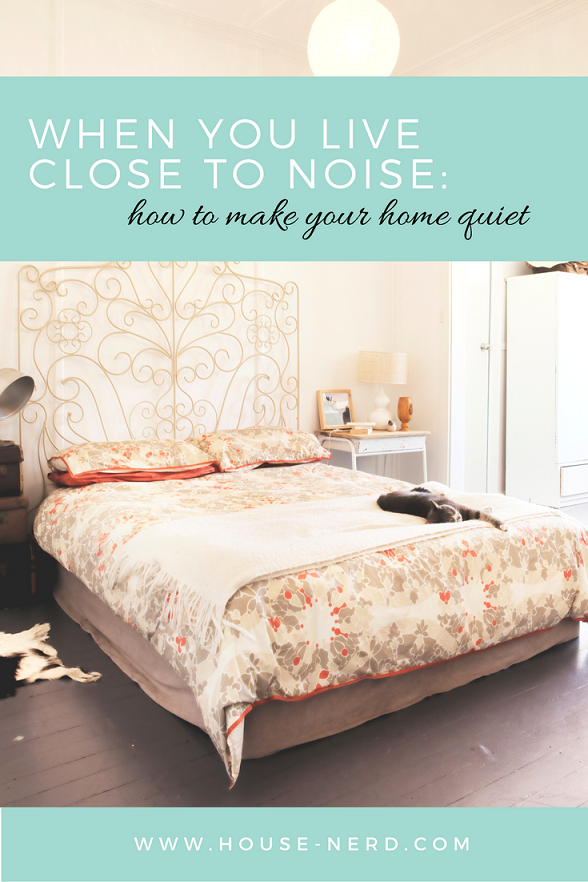
1. Furniture and its careful placement can improve the situation.
Think of the concept of sound being like water. The same way water runs, so does sound. Noise will sneak through gaps and cracks. If you try to stop sound going one way it will go another. It can be a helpful way of looking at sound problems, such as traffic noise from the street. We’ve all noticed how much a house devoid of furniture can echo and it shows you just how much an open, empty room will amplify even a small sound. A tip for dampening noise pollution is to add soft materials and upholstered furniture to your room.
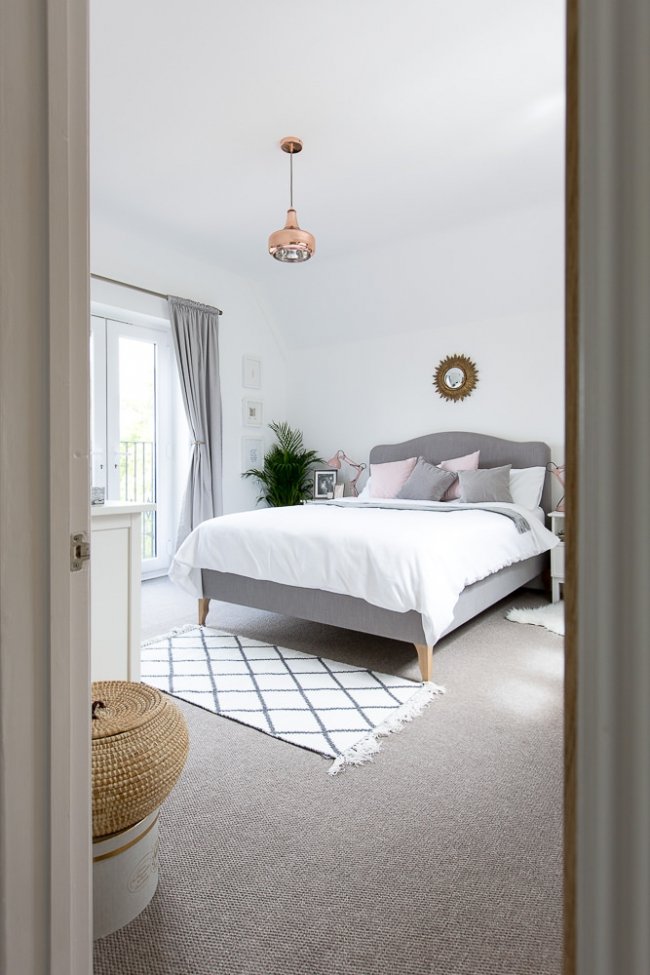
This lovely bedroom makeover from Rock My Style not only looks lovely and calm, but with all those material elements in it, I will wager money that it is quiet, too.
I know minimalism and bare spaces with little furniture are very in, but it might not be the most conducive environment for good sleep if you live in a noisy area. Adding big pieces of furniture that feature a lot of material (like sofas or beds) actually help break up soundwaves and help prevent sound from travelling from the street to the back of the home. Believe it or not, incorporating soft materials like fabric and plush furniture into a bedroom or living area can help.
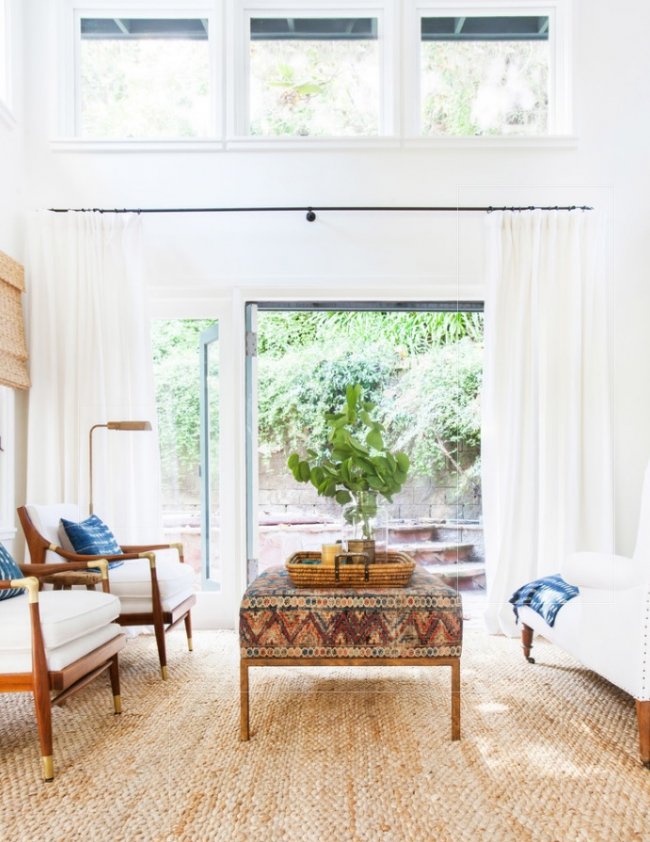
This 1930s Californian home from Houzz features a natural fibre rug, heavy curtains, an upholstered ottoman and fabric chairs - all elements that can help reduce noise in a room.
Furniture placement can also help mask or dull noise coming from outside the house. If you have a bedroom or living room that looks onto a noisy street, try positioning a large dresser or a large bookcase filled with books against that wall to help deaden traffic noise. You could also add a comfortable upholstered armchair in front of a window (this replica Grant Featherston chair by Matt Blatt has a nice shape and comes in enough different colours to suit a lot of bedroom schemes)
or an upholstered ottoman or storage bench.
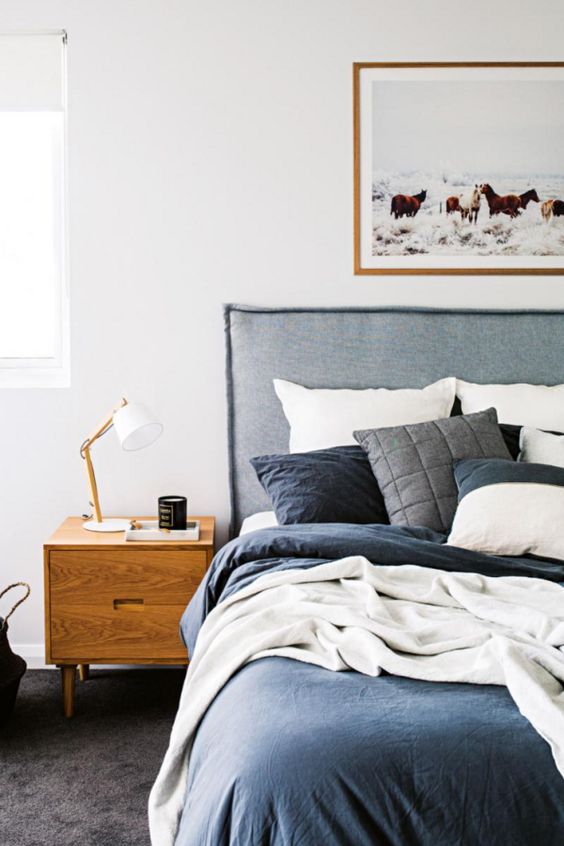
Cosy bedroom with upholstered bedhead from A House in the Hills.
2. Add textiles.
There's a reason so many hotel rooms feature heavy curtains, carpeted floors and upholstered bedheads and walls - textiles help create quieter rooms. Add a rug, textiles, heavyweight thick curtains, throw cushions throughout your bedroom and living areas. You want to ‘soften’ the soundwaves bouncing around your home, and textiles help! You’ll never think of throw cushions as purely decorative again – no, they’re little soundwave sponges.
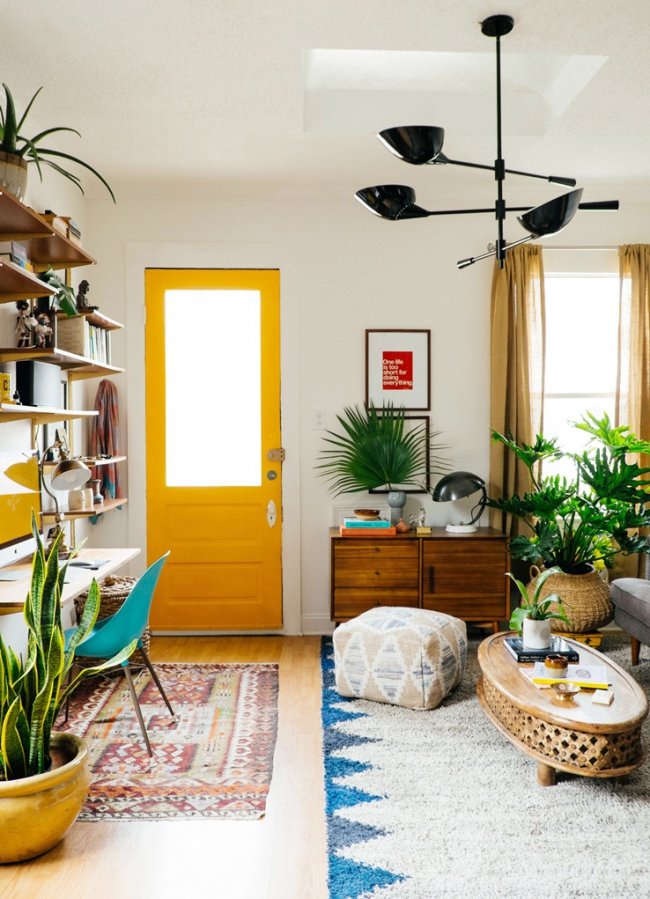
I really like this fun room makeover featured on Front + Main - a small apartment, but so much personality and a fun kind of jungalow style with lots of textiles. Things like the rugs, big fabric couch, curtains, upholstered ottoman and lots of throw cushions make it cosy AND quiet. (And I love that yellow front door too).
3. Swap out hollow-core doors for solid ones.
My in-laws used to live in a 1960s character cottage on Riseley Street, which was always a rush of traffic, particularly in peak hour. While they lived on a busy, noisy road, what was always nice about that house was how quiet it was once you closed the front door. They always say that swapping out their old doors for heavy, solid timber ones helped massively. That house was QUIET.
And also – door seals. That insignificant-looking little crack at the bottom of your door is actually letting in a lot of noise! Invest in a door-seal kit designed for sound reduction.
4. Landscape for peace and privacy.
So remember how I said sound can bounce off surfaces and be directed to go one way or another? You can muffle sound or help direct it in a different direction – like with a garden wall. Many people swear that building a solid brick or limestone wall has helped with their noise reduction, and planting trees and hedges can also be an aid.
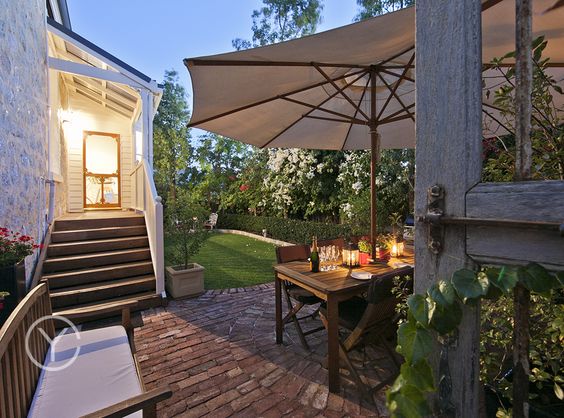
My in-laws had this beautiful robinia that I think contributed to noise blockage– the foliage of robinias is so dense and they grow quite quickly. Conifers and every green hedges are the best for year-round noise blocking.
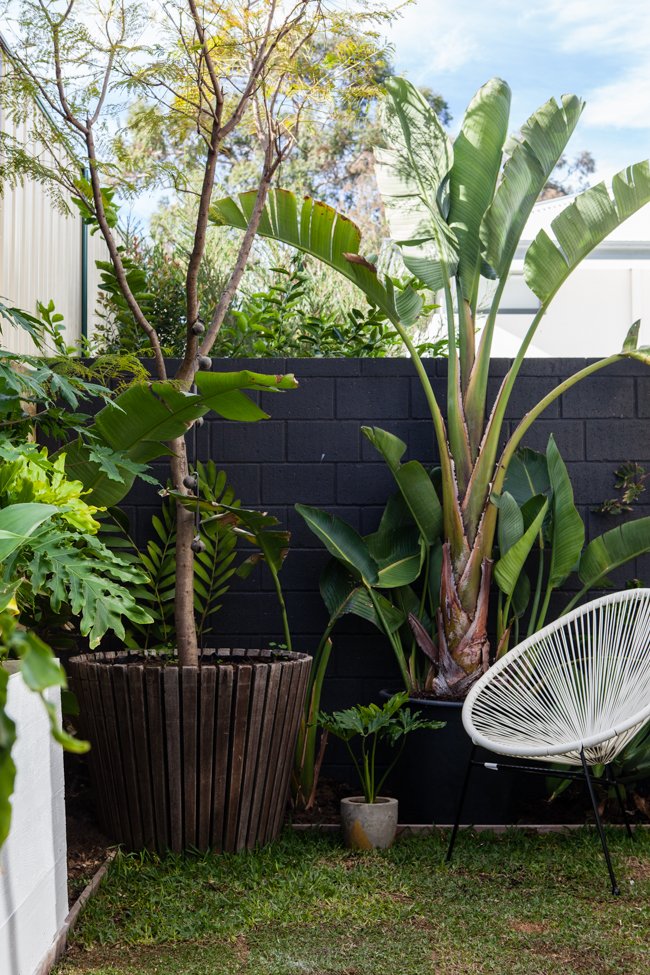
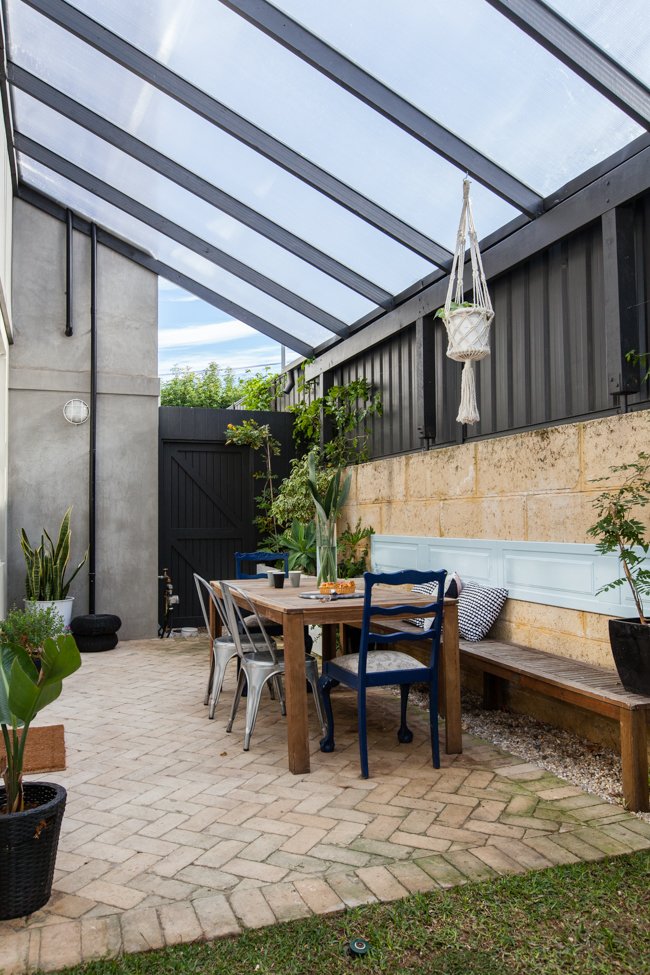
ABOVE: These photos are of the lovely outdoor area of Two Apartment House by Etica Studio, which I featured here. It's in a suburban location yet feels so private and quiet. Photos: Heather Robbins.
You can also try to mask traffic noise with ‘prettier’ noises such as a fountain, stacked stone water feature or tall ornamental grasses or bamboos. When it comes to hardscaping, hard exterior surfaces like concrete paving all around your house will actually ‘bounce’ sound around rather than absorbing it. Opting for ‘softer’ materials in your outdoor areas (especially in areas with higher housing density) like garden beds, gravel paths, shrubs, bushes and trees will help absorb traffic sounds.
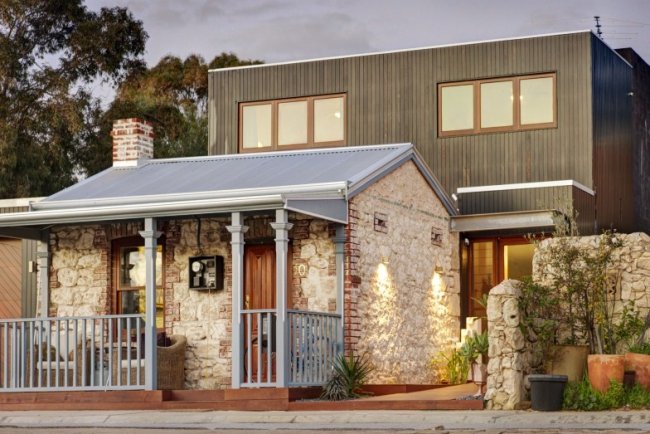
I featured this Fremantle cottage (with stunning modern addition) a while back here and still adore this house. It's on a quiet street but one street back from a busy road (and if you look closely you can see the house comes right off the footpath) so the area has a bit of traffic noise in peak hour traffic - but you can't hear the noise when you're inside. Water features in the small outdoor areas help to cover the noises of traffic. Photo by Squint Photography.
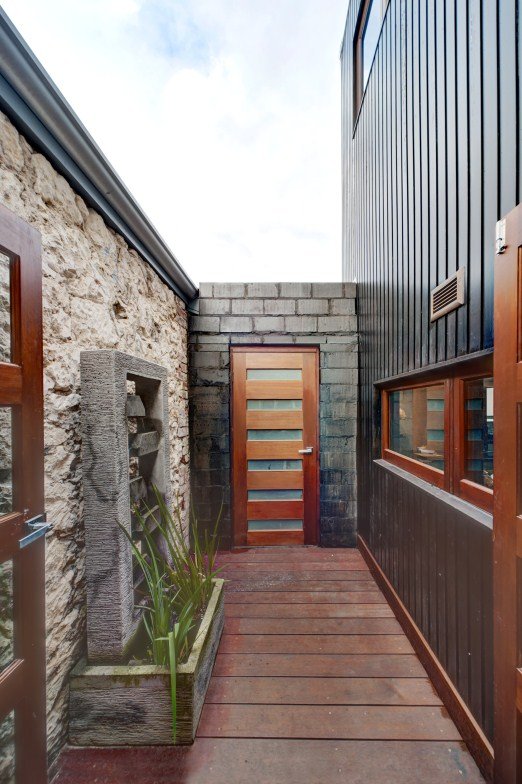
This Fremantle home tour I featured here has water features in the garden to soften the sounds of traffic. Photo by Squint Photography.
5. Old weatherboard or fibro cottage? Look at how you can reduce street noise coming through your walls.
Old weatherboard cottages are beautiful and we have a lot of them in Australia – but they are notorious for letting in external noise, especially if they are old and come with typical small gaps and cracks that will let in street noise. A lot of people see (well, hear!) a difference straightaway when they make an effort to seal up holes and cracks around windows and doors. (Use a good-quality latex or polyurethane caulk).
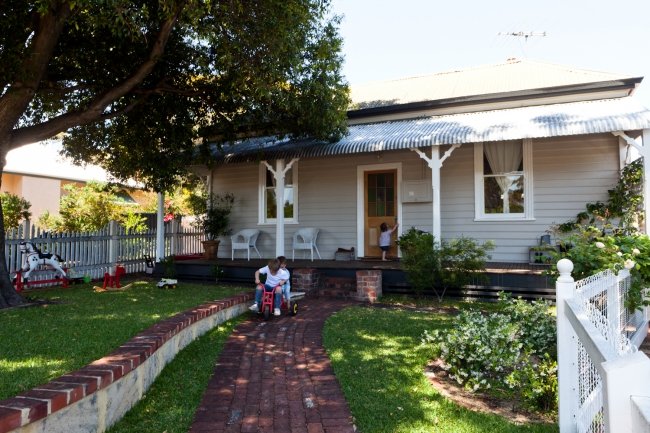
I loved this Palmyra home tour. Photo: Heather Robbins.
If you love your old weatherboard house and location but not the noise pollution it comes with, it might be worth looking at whether you could put in specially designed acoustic insulation (check the acoustic rating on the batts) or talk to a builder about ‘thickening’ some walls internally in some way with a material such as acoustic plasterboard. There is a product called Barrierboard, which is an Australian product that consists of an acoustic insulation layer sandwiched by of two layers of plasterboard of varying thickness and is designed to absorb noise. (Experts say that composite construction using combination of both light and heavy mass materials is the best for reducing noise transmission). The only downside to adding another ‘layer’ for soundproofing is that you will slightly reduce the amount of space in your room (Barrierboard is 32mm thick). However it’s not a bad sacrifice to make if it means a decent night’s sleep! This forum discussion shares a couple of interesting points of view.
If you are after some more technical information on reducing traffic noise coming into your home, this is a good government article with technicalities and tips.
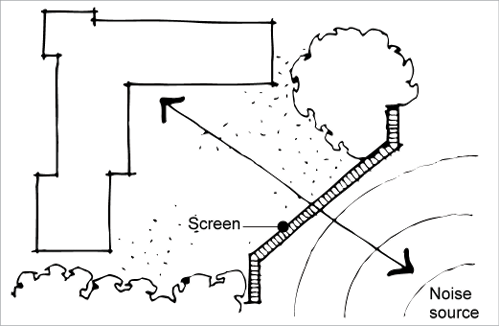
6. Pad out your walls with soundproof panels.
Sounds daggy? Remove those images of dark, depressing, dust-attracting soundproofed studios from your mind. If you are desperate for noise reduction, there are actually some options available today that aren’t horrendous-looking. Some companies offer acoustical fabric-covered acoustic panels that you attach to your wall and you can also get peel-and-stick tiles. I actually don’t mind the look of some of these panels if they were used in the right setting - I think you could make them work in a kids’ room or a funky dining room or a mid-century modern home. These panels in the dining room are from a company called Wall Art - they are eco-friendly, modern, paintable and have acoustic properties.
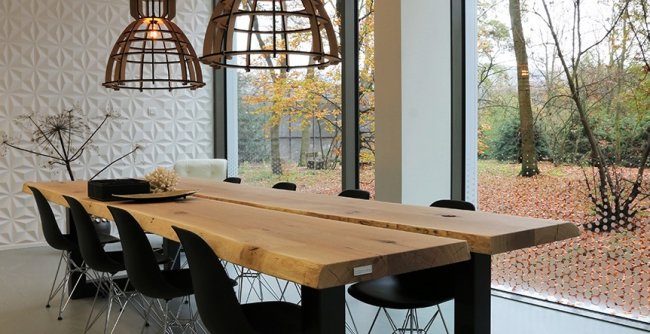
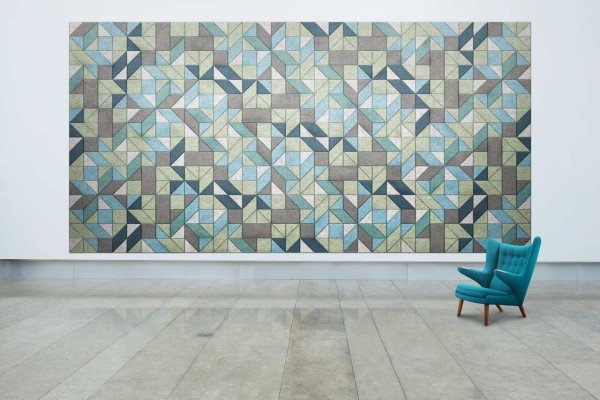
These are Baux sound absorbing tiles. Of course, they're made by a company in Stockholm!
7. Put in carpet or add rugs.
We don’t have carpet in our house and one thing I notice when I go to homes with carpet, even those situated on a busy road, is how the carpet helps absorb street sound or just when it comes to internal noise from a ground floor (which is why you see a lot of two-storey homes where the upper floor is full carpeted, to minimise noise transference between each level). If you are extending your home upwards, you can install acoustically rated underlay in these rooms to dull noise. Don’t forget that when it comes to flooring, hard surfaces like tiles or hardwood will ‘heighten’ any sound in the space. Don't want to do carpet? Adding rugs can help a room seem quieter.
A layered, textile-rich bohemian living space featured on Better Homes and Gardens. 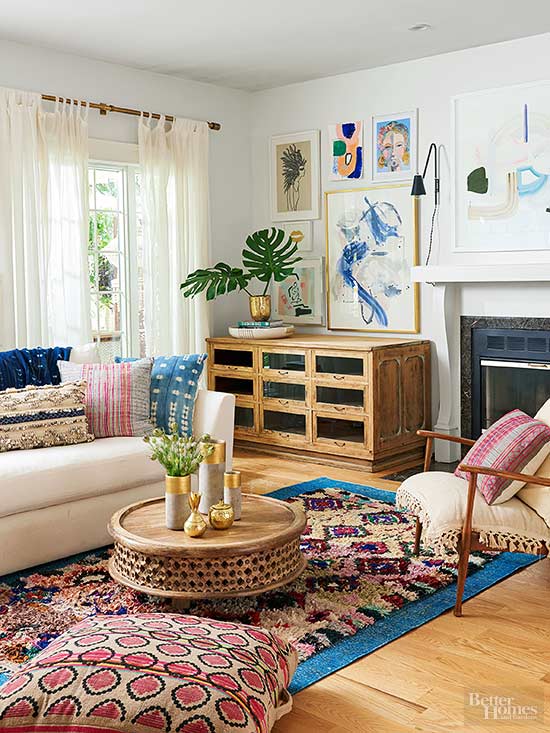
8. Put in double-glazed windows.
Windows are one of the biggest sources of external noise penetration in a home. One of the biggest renovating changes we made to our 1970s house was installing all new windows with double glazing (and low-e glass) in place of our old, original aluminium windows with very thin glass. To be honest, I was initially doubtful that it would make much difference, but it has – it’s now quieter inside our home. Not so much so you don’t hear anything, but it’s quieter. Double-glazed windows give great soundproofing because the air cavity between the two panes helps to buffer noise. Gaps mean noise, so caulk existing windows so they are airtight and put in gaskets to really make the seals super airtight (and more soundproof).
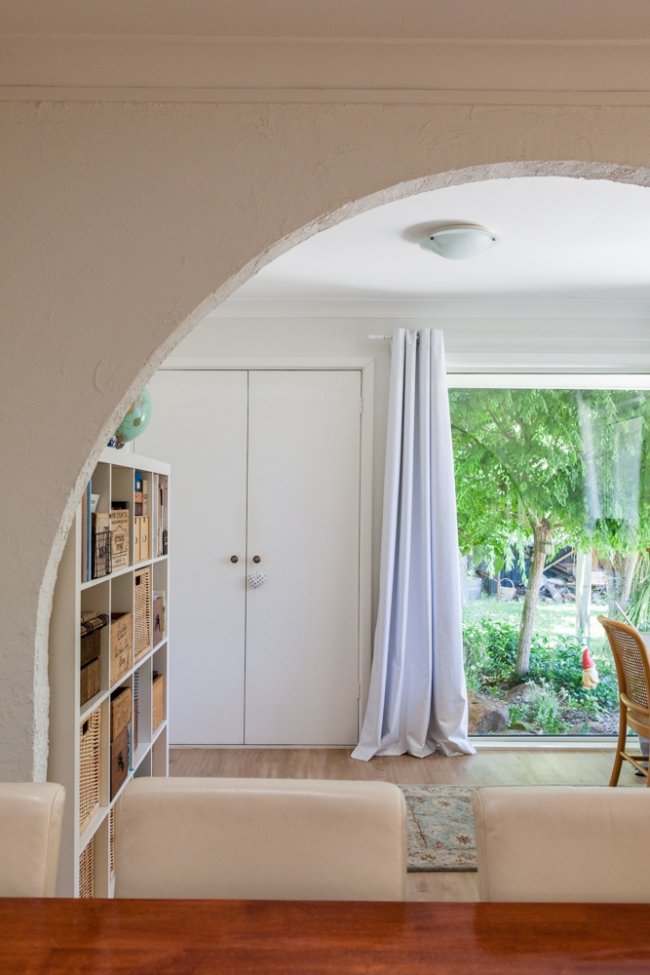
Our double-glazed window in my study. Photo: Heather Robbins.
Double-glazed windows aren’t cheap, so if you live on a busy road but are on a budget perhaps look at doing them just at the street front side of the house. (Our new windows also help keep our house at a much nicer temperature all-year round. We hardly ever need to use the air-conditioning in summer anymore unless it’s really, really hot and in winter the house doesn’t feel as cold).
9. Top your windows with layers.
Soundproof your windows by adding thick curtain and window treatment layers that feature heavy materials like wool, velvet or vinyl layers to help absorb street noise. Some companies specialise in selling ‘soundproof’ curtains and window treatments – I have no idea how good these are but worth looking into.
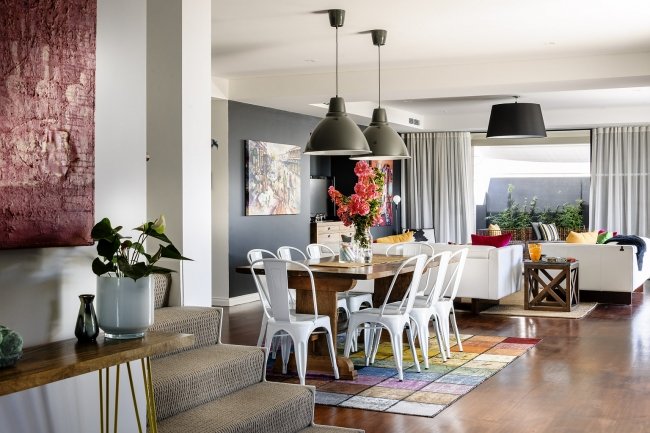
Thick curtaining in this home I featured back here. Photo: Joel Barbittas of D-Max Photography.
10. Consider roller shutters to streetside windows.
If traffic is waking you up at night, externally you could add roller shutters. My in-laws put in automated roller windows at the front of their old home and said the amount of traffic noise they cut out was great. It’s said though that some types can reduce noise coming through a window by up to 75%. Not everyone will think that they are worth it, and likewise not all brands and styles will have the same effect, so shop around. I know they’re not the prettiest thing and might conjure up images of 1980s roller shutters in bad patterns - however there are lots of brands these days that are much more streamlined, modern and unobtrusive-looking.
11. Consider cavity sliding doors for extra noise reduction.
Open-plan living spaces are very fashionable these days but often these large living spaces, particularly if they are fully tiled or have floorboards, often result in noise carrying and echoing through the room.
Cavity sliding doors or just regular sliding doors might be an option if you want to help prevent noise transference between room to room and you have a doorway. We have an old sliding door, nothing special to look at, but it sections off the minor bedroom wing from the rest of the house and we often close it when Little Nerd is asleep and we have friends over for dinner and drinks. And if you want it to look stylish? Barn sliding doors look awesome and really add character to a room. A blog reader recently informed me that you can purchase the hardware needed to make them off eBay. (Someone do one and share photos with me please).
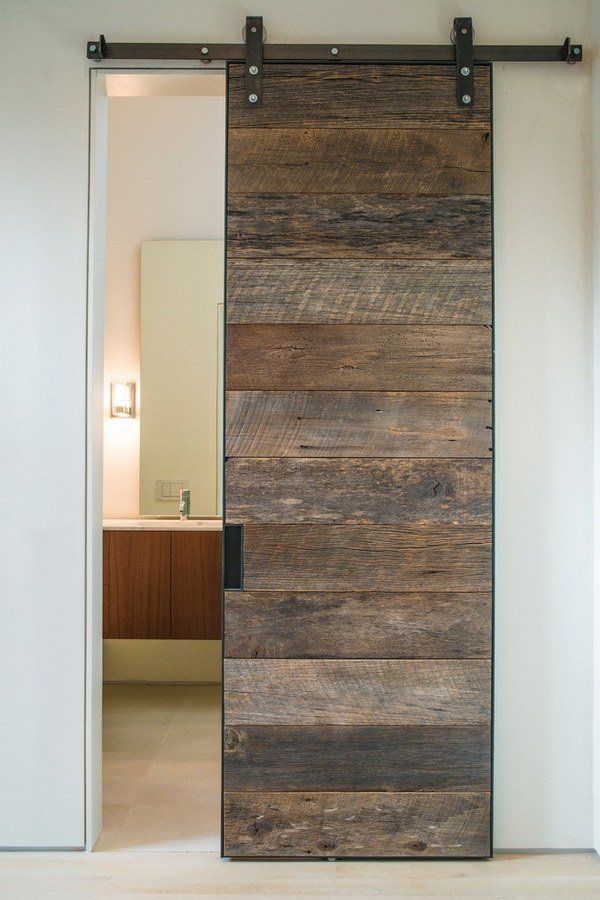
12. Add underfloor insulation.
This tip comes from House Nerd reader Gemma Haynes. "We had underfloor insulation sprayed under our house," she says. "It has made a huge difference to sound and stops drafts coming up through the original jarrah floor."
Have you ever lived in a noisy home or location? How did you deal with it? Is a noisy location a deal breaker for you when buying a home? Maya x
Thanks to Matt Blatt for sponsor-supporting this story! You can visit their website here or follow them on Instagram or Facebook here.
Love homes and design tips? You can follow House Nerd on Facebook, Instagram @housenerd, Pinterest, Twitter @HouseNerd_ or Bloglovin.















